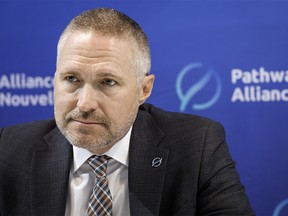
[ad_1]
It’s been more than two years since the Pathways Alliance was officially launched in June 2021, with Canada’s biggest oilsands operators unveiling plans to work together to build the world’s most ambitious carbon capture network in Alberta.
The $16.5-billion proposal, which includes a 400-kilometre pipeline that will connect more than 20 oilsands facilities to a storage hub near Cold Lake, is deep in the planning phases, although a final investment decision hasn’t been made.
The pace of progress is quickly becoming a source of frustration with Ottawa.
Federal Natural Resources Minister Jonathan Wilkinson says he wants more action, and less advertising, on the plan by the oilsands producers to reduce their emissions by 22 megatonnes annually by the end of the decade.
“It is now time for the industry to start to show actual progress on the ground,” Wilkinson said in an interview Thursday.
“We are, every day, moving closer to 2030 and it is time that we stop just advertising on television the great things we’re doing from an environmental perspective, and actually put shovels in the ground.”
The MP for North Vancouver said he will deliver this message to the heads of the alliance, which represents six of the largest oilsands producers — including Suncor Energy, Cenovus Energy, Imperial Oil and Canadian Natural Resources — when he meets them in the coming weeks.
It should make for an interesting get-together.
On Thursday, leaders with Cenovus Energy discussed the work the alliance has already taken. They also noted that more details still need to be ironed out on planned government incentives required for the development to proceed.
The alliance is getting ready in the next few months to submit the necessary regulatory applications for the pipeline and the pore space to store the captured CO2 emissions deep underground.
Complicating the situation is an incoming federal emissions cap on the oil and gas industry that is fiercely opposed by the province and the industry.
“There’s no doubt that to reach the 2030 targets of what’s doable, we need to move on that (project) today,” Cenovus CEO Jon McKenzie said Thursday on an earnings call.
“But we can’t move on those targets until we get the certainty from the levels of government that we’re currently negotiating with, that allow for certainty and investment in these kinds of projects.”
A report released this week by energy consultancy Wood Mackenzie said the challenge for the carbon capture, utilization and storage (CCUS) project isn’t the level of provincial and federal government incentives, but the lack of certainty surrounding their existence in the future.
It says such incentives in Canada are already much higher than in the U.S., but if the federal and provincial governments can’t collaborate to “underpin this uncertainty, few CCUS projects will move forward and most, if not all of Pathways, will be delayed and potentially scuppered.”
“In reality, they’re not that far apart,” said Peter Findlay, Wood Mackenzie’s director of CCUS economics.
“The holdup is uncertainty and incentives, for the most part, and who’s going to take the risk of what the price of carbon is going to be . . . if it becomes a game of chicken where nothing gets done, then everybody loses.”
-
 World’s biggest carbon-capture project at risk, Wood Mackenzie warns
World’s biggest carbon-capture project at risk, Wood Mackenzie warns -
 November 2023: Pathways Alliance increasingly confident $16.5B carbon capture project will go ahead
November 2023: Pathways Alliance increasingly confident $16.5B carbon capture project will go ahead -
 November 2023: Varcoe: Alberta energy firms ‘encouraged’ by new federal incentives for carbon capture and storage
November 2023: Varcoe: Alberta energy firms ‘encouraged’ by new federal incentives for carbon capture and storage -
 Varcoe: Provincial report warns of $600B hit to Canadian economy from federal emissions cap
Varcoe: Provincial report warns of $600B hit to Canadian economy from federal emissions cap
Carbon capture and storage is seen as a critical technology to help decarbonize the country’s oil and gas sector. The industry is the largest source of greenhouse gas emissions in Canada.
Members of Pathways Alliance are collaborating to reach net-zero emissions in the oilsands by 2050, which matches the federal climate target.
The group has been working together for more than two years on the foundational CCUS project, which is expected to capture carbon and sequester approximately 10 to 12 megatonnes annually by 2030.
It’s part of a broader plan to lower oilsands sector emissions by 22 megatonnes by 2030. The group has said it anticipates investing $24 billion by the end of the decade in various decarbonization initiatives.
The alliance has been waiting for the Liberal government to work out the details and pass legislation to enable a long-promised federal investment tax credit (ITC), which would provide up to a 50 per cent credit for carbon capture developments.
It’s also waiting for Ottawa to release more details on how it will provide long-term certainty on the future price of carbon, through carbon contracts for difference.
Meanwhile, the Alberta government unveiled a program in November to provide a 12 per cent grant on eligible capital costs for companies to build CCUS facilities.
In a statement, Alberta Energy Minister Brian Jean’s office said the province “is continually pushing both Pathways and the federal government to make progress in developing the operational supports . . . that would allow this important national project to advance.”
Pathways Alliance president Kendall Dilling said the sides are well on their way to having a fiscal framework in place to support the investment, but it’s largely “theoretical.”

Canada has been talking about the federal investment tax credit for more than two years, although it has yet to be fully legislated. As for the federal carbon contracts for difference, “to date, that’s all it is, is talk — there’s been nothing concrete,” he said.
The group will file regulatory applications this year and assuming approvals are in hand, a final investment decision could take place in the second half of 2025.
“On paper, we’re still on track for that. But the longer this takes, the more and more (that) any schedule slack disappears,” Dilling added.
“We’re very much moving the project technically forward in good faith, on the assumption that all the other pieces will fall into place. And if there’s a delay, it won’t be because we’ve not done our part.”
The federal resources minister said he’d like to see the oilsands group move forward with procuring long lead items that take time to deliver, and progress detailed engineering work.
“I am getting concerned. I mean, 2030 is not very far away,” Wilkinson said.
“It’s time to get on with it.”
Chris Varcoe is a Calgary Herald columnist.
[ad_2]
You can read more of the news on source




